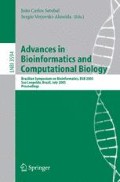Abstract
Trimming procedures are an important part of the sequence analysis pipeline in an EST Sequencing Project. In general, trimming is done in several phases, each one detecting and removing some kind of undesirable artifact, such as low quality sequence, vectors or adapters, and contamination. However, this strategy often results in a phase being unable to recognize its target because part of it was removed during a previous phase. To remedy this drawback, we propose a new strategy, where each phase detects but does not remove its target, leaving this decision to a post processing step occurring after all phases. Our tests show that this strategy can significantly improve the detection of artifacts.
Access this chapter
Tax calculation will be finalised at checkout
Purchases are for personal use only
Preview
Unable to display preview. Download preview PDF.
References
Baudet, C., Dias, Z.: New EST trimming strategy. Technical Report IC-05-09, Institute of Computing - University of Campinas (May 2005)
Cattle EST Project - The W. M. Keck Center for Comparative and Functional Genomics, University of Illinois at Urbana-Champaign (January 2005), http://titan.biotec.uiuc.edu/cattle/cattle_project.htm
Chou, H., Holmes, M.H.: DNA sequence quality trimming and vector removal. Bioinformatics 17, 1093–1104 (2001)
Green, P.: Phrap Homepage: phred, phrap, consed, swat, cross_match and RepeatMasker Documentation (March 2004), http://www.phrap.org
Scheetz, T.E., Trivedi, N., Roberts, C.A., Kucaba, T., Berger, B., Robinson, N.L., Birkett, C.L., Gavin, A.J., O’Leary, B., Braun, T.A., Bonaldo, M.F., Robinson, H.P., Sheffield, V.C., Soares, M.B., Casavant, T.L.: ESTprep: preprocessing cDNA sequence. Bioinformatics 19(11), 1318–1324 (2003)
Telles, G.P., da Silva, F.R.: Trimming and clustering sugarcane ESTs. Genetics and Molecular Biology 24(1-4), 17–23 (2001)
Author information
Authors and Affiliations
Editor information
Editors and Affiliations
Rights and permissions
Copyright information
© 2005 Springer-Verlag Berlin Heidelberg
About this paper
Cite this paper
Baudet, C., Dias, Z. (2005). New EST Trimming Strategy. In: Setubal, J.C., Verjovski-Almeida, S. (eds) Advances in Bioinformatics and Computational Biology. BSB 2005. Lecture Notes in Computer Science(), vol 3594. Springer, Berlin, Heidelberg. https://doi.org/10.1007/11532323_24
Download citation
DOI: https://doi.org/10.1007/11532323_24
Publisher Name: Springer, Berlin, Heidelberg
Print ISBN: 978-3-540-28008-8
Online ISBN: 978-3-540-31861-3
eBook Packages: Computer ScienceComputer Science (R0)

